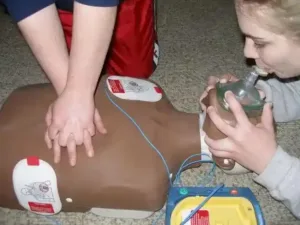Participants enrolled in first aid or CPR and AED training may be trained in oxygen application for unconscious and conscious victims. Participants will learn the components and proper usage of an oxygen unit. Candidates will learn safety factors and delivery devices involved with oxygen units. To successfully complete some CPR and AED courses participants will need to learn and demonstrate how to use an oxygen unit safely and effectively to provide supplemental oxygen to a patient. This page is dedicated to participants that want to know the components to successfully complete the oxygen unit component of a advanced ABC management component of a first aid and or CPR course.
To successfully complete the oxygen component of a first aid and / or CPR course rescuers must:
-
Instead of doing mouth-to-mouth resuscitation (shown in picture above) some providers teach candidates additional skills in oxygen administration. Identify the components of a oxygen unit.
- Demonstrate the correct assembly of a oxygen unit.
- Demonstrate safe handling and storage of a oxygen unit.
- Understanding how and when to replace a oxygen unit safely.
- Ability to use a regulator to determine the pressure and flow rate.
- Ability to calculate oxygen availability based on flow rate.
- Safety precautions must be demonstrated throughout.
- Show the appropriate choice of delivery methods and flow rates for patients condition.
- Monitor patients ABC’s continually and throughout oxygen delivery.
- Be able to deal with complications such as vomiting and patient refusal.
- Be able to complete appropriate follow up and accurate record keeping.
Additional Notes:
- Oxygen cylinders are under high pressure so candidates must follow proper safety precautions. Candidates must not use oxygen unit around a open flame, petroleum products, with rough handling. Rescuers should also never use a damaged unit.
- Components that candidates may be required to be aware of include a cylinder, medical post, pin indexing, regulator and wrench.
- A typical D-cylinder holds 350 litres of oxygen. When filled to 2200 psi the oxygen unit will last approximately 20 to 40 minutes depending on flow rate.
- Common flow rates include 10 litres per minute for conscious victims and 15 litres per minute for patients requiring assisted ventilations.
- A oxygen tank should never be bled dry. Oxygen unit should be refilled or replaced at 200 psi.
To successfully complete the oxygen component of a first aid and / or CPR course candidates should have the skills and knowledge of the components posted above. Proper oxygen implementation and use can significantly increase the positive results for patients that are either conscious or unconscious. The material posted on this page is for information purposes only. To learn to use a oxygen unit take a CPR or first aid course that includes this component. Other advanced components of oxygen therapy is the addition of manual suction and how to cope with rescue breathing complications. All of these topics can be covered in advanced training combined with CPR. For more information contact our St Mark James providers in your region.
Contacting the Providers in your Region
We are partnered with the best St Mark James training providers throughout Canada. They offer a range of CPR and AED certification programs at various locations and times. Visit the locations page for more information about course locations or select your location from the menu. Register for CPR and AED classes in Regina, Winnipeg, Vancouver, Calgary, Edmonton, Saskatoon, Red Deer, Victoria, Toronto, Halifax, Kelowna, Hamilton, Mississauga, Thunder Bay and Windsor. All of our training partners provide convenient and comfortable registration and programs.


Looking for O2 admin coursein Alberta,preferably Edmonton. ASAP. Thanks